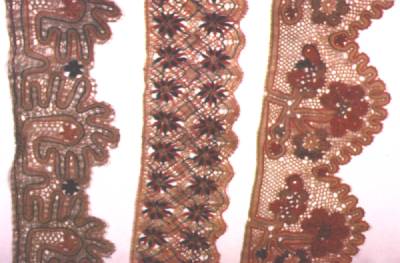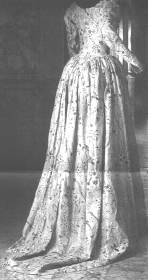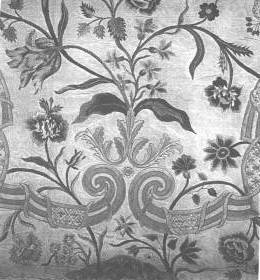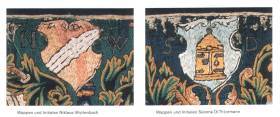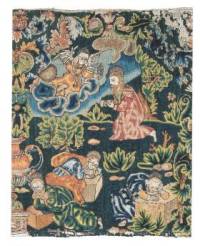Samplers from the
Victoria and Albert Museum
By Clare Browne and Jennifer Wearden,
London 1999ISBN 18 5177 309 6
£ 25.-
112 coloured photographs
the chapters of
the book are:
1. samplers in the museum's collection
2. list of plates
3. the plates
4. stitches and techniques
5. glossary with diagrams and explanations
6. select bibliography
Embroidered
samplers from the outstanding collection in the
Victoria and Albert Museum provide both a
historical survey of this popular needlework art
and a practical guide to the different types of
stitches.
Details of individual motifs are shown alongside
full colour photographs of the complete samplers
while stitch types and techniques are explained
through photographic details and clear line
drawings.
Samplers provides a gallery of some of the most
important and beautiful pieces in the V&A and
an opportunity to see in close-up fragile objects
which by their nature cannot remain on permanent
display or to be seen in strong light.
|

|
The book is international
in its scope, illustrating British, Continental and
non-European samplers, and covers a wide range of stitch
types, providing practical information and inspiration
for designers and embroiderers. It will also be of
interest to collectors and to those interested in the
wealth of historical detail revealed in the evocative
images.
Eef
de Jonge-Everaert
„Door mijn gedaan", de geschiedenis von de
Zeeuwwe merk- en stoplap
(„Done by me", the history of the Zeeland
sampler and darning sampler)
Text in Dutch, published
by the Vereniging van Zeeuwse musea en Bureau provinciaal
museumconsulent Zeeland,
Text in Dutch, illustrated in colour and black and white,
bibliography
The Bureau Provinciaal
Museumconsulent Zeeland has changed its setup and name
since 2000. It can best be reached at Stichting Cultureel
Erfgoed Zeeland, SCEZ, Postbus 49, 4330 AA Middelburg,
email info@scez.nl.
An exhibition 'Door ons gedaan' , the longest
sampler in the world, was shown in Japan in 2009. A
description of it can be found on the website: http://www.scez.nl/index2.php?/pagina.php?nummer=910~mainFrame which can be translated into English (very
badly!!!) on the Google browser.
Unfortunately, the book "Door mijn gedaen, de
geschiedenis van de Zeeuwse merk- en stoplap" by Eef de Jonge-Everaert, published
by VZM/BPMZ, isbn : 9789090129662, is not in stock at http://www.dedrvkkery.nl/option=com_mbhbooksheet&task=bookview&Itemid=10039&query=9789090129662&disp=&kml=1&bav=0&delc=0
Sent by Pat Griffiths
A nice publication on samplers in the province of
Zeeland in the Netherlands with numerous
illustrations, including a titlepage painting of
the first quarter of the 20th century
showing a girl in Zeeland costume in front of a
mirror with a framed darning sampler on the wall
behind her. The text gives a general survey of
the history of samplers in the province, notes on
schools and typical Zeeland motifs, some of which
are linked with samplers in England, Denmark and
North Germany. The stories are told of various
girls and their samplers, beginning with one born
in 1750 and ending with one who lived through
almost the whole of the 20th century.
Samplers for special occasions are covered and so
are articles of regional costume on which sampler
motifs were embroidered.
Since the book was compiled in the context of
aconsideration project carried out in 1997-8,
there is a final chapter on the conservation and
framing of samplers.
|

|
There are also
lists of motifs and their symbolism and museums
in Zeeland with samplers in their collections.
The book costs less than 25 guilders and even if
you cannot read Dutch, is would be a useful
addition to any library of sampler publications.
|
| Newsletter No 9, p. 3,4 already
gave a short information about this catalogue and
the exhibition Soieries en
Sacristie
Fastes liturgiques, 17e – 18e c.
par Christine Aribaud, Paris 1998
Text in French,
199 pages on every page one or several colour
photographs
ISBN 2-85056-337-4
Reported by A.W.
The musée Paul Dupuy in Toulouse was founded in
1949, its aim is the exploration of all the kinds
of art in Toulouse and in its surroundings.
Christine Aribaud was commissioned to form an
exhibition on religious textiles and to write a
catalogue. This exhibition on vestments of rural
parishes in the region of Toulouse and its
surroundings took place from 26th
october to 31th january 1999.
In the first
chapter the author treats the Concile of
Trient and its consequences for Toulouse. After
his stay in Italy the archbishop of Toulouse
convoke the 14th concile of Toulouse
which established the resolutions of Trient.
|
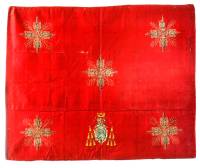
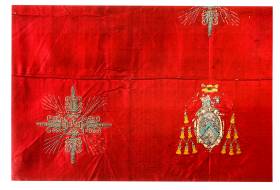
|
| The visits of the Bishop in the
single parishes became very important. For
instances, some questionnaires are preserved on
which are listed all objects which a community
should have in possession corresponding to the
resolutions of Trient. Especially between 1603-17
and 1630-44 there were intensive visits and
controlls in the communities and they lasted
until the 18th cent. Chapter 4 treats the
embroidery craft of Toulouse thoroughly. Since
medieval times the corporation of the
embroiderers was joint to the one of painters and
sculptors. Since June 7th 1505 the
embroiderers had their own corporation. Later on
they united with the goldsmiths. It is known that
Nicolas Escudier set up the regulations between
the end of the 16th and the beginning
of 17th c. He became master
embroiderer in 1604.
Unfortunately these regulations have not been
found up to the present day. There are other
descriptions which mention an apprenticeship but
they do not tell its duration. For the right to
become a master in 1621 there had to be paid
„sept soulz six deniers" and in 1649
„15 sous".
|
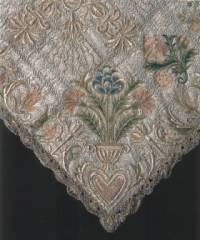
|
| Besides the
future master had to present some practical work
of embroidery which normally are described in
detail in the regulations. With this piece of
work the applicant had to proof his ability for
embroidery. It was judged by the elected
„bayles brodeurs". The ceremony of
presentation took place before the „
capitouls dans la salle du Consistoire du
Capitole". In Toulouse it exists a „libre
des Mestiers" since 1596 and here
registrations of masters of embroidery have
been found. In particular names are listed and
therefore it is possible to give a chronological
list of embroiderers: From 1600 to 1625 there
were 25 masters, from 1650 to 1700 there were 13
masters, from 1700 to 1750 there were 3 masters
and from 175o to 1790 there were 3 masters.
Moreover from 18th c. there have been
found a great number of executed embroideries.
As a speciality a
calice veil of Saint-Lizier is preserved, worked
by the embroiderer Manaud Troy.
He was born 1574 in Castaignac close to
Saint-Ybars. He was married on June first 1604 to
Benoise du Roy the widow of master embroiderer
Henry du Roy. In 1606 he became embroidery master
himself and one year later „bayle
brodeur". Some more events concerning Manaud
Troy are known: In 1618 he enrolled an apprentice
and in 1635 he embroidered a cope for Bruno de
Ruade, bishop of Saint-Lizier. It is a late works
of his, he died on february 4th 1639.
In his family there are several embroiderers, for
instance Pierre Troy the son of his brother, who
became an embroiderer in 1639. It may be him who
installed in 1639 in Carmes. Maurice Troy, Pierre
Troy‘s son, became master in 1716.
Church vestments
were also adorned by nuns. Very rich work is
known of the Carmelits at Lecoutre or of the
Augustins in Lisle-sur-Tarn. Specially these
embroideries are inspired by botanical designs
Chapter 6
deals with the fashion in patterns of fabrics.
There are no special religious pattern and
priests ordered the most modern design. Identical
designs can be found today in a damasc in the
royal palace of Madrid. Some other designs show
the general tendencies of the time. Reports of
the years 1739-1743 show that in Tours velours
was woven in the manner of Genova. In 1740 the
italian Giuseppe Solary settled in Tours and in
1744 the name of the manufacture was:
„Manufacture Royale de damas façon de
Gênes".
Other patterns clearly show inspiration of the
ornamentists of the time:
Jean Bérain‘s design can be found in the
chasuble of Montpezat de Quercy.
Jean Pillement (1728-1808) inspired a chaperon of
the chasuble in the musée Pasul Dupuy.
Jean Revel who introduced since 1732 the
technique of „points rentrées", also
inspired
patterns.
In the field of lace there is no distinction
between religious and secular design. Lace can be
used as borders of albs or altar hangings. In the
17th c. it is used every where in
men‘s costume.
The church never opposed against fashion fabrics
and priesthood received some cultural importance.
As a conclusion
the author informs about her inquiry in the
parishes about the preservation of church
vestments, and whether vestments should rather be
kept in Museums collections. She points out the
dangers which rests upon this estate. The
preservation of vestments in possession of rural
parishes is not always easy. In many cases the
conditions are perfect and the priests are well
aware of their responsibility but there is little
time and no money to really take care of this
estate. Sometimes vestments are kept in drawers
which are swollen by humidity. In this way they
may become victims of neglect.
In the
catalogue there are listed: religious
textiles, secular objects and non textiles
objects. Among the 31 chalice veils there are 6
embroidered examples and most of these veils
belong to a whole set of vestment. Embroidered
are two altar frontals (end of 16th
and beginning of 18th c.), 2 shrines
(17th c., and a coat of arms (19th
c.)
|
Indian
Embroidery Techniques at the Calico Museum of Textiles
compiled by Professor Anne Morrell, 1999
published by: Sarabhai Foundation, Opp. Underbridge,
Shahibag
Ahmedabad - 380 004, India
Phone: 286 8 172, Fax: 286
5 759
ISBN: 81-86980-04-0
For easy use the guide is
in four folded sections which are housed in a cover. This
publication is in colour, at a price of US$ 20 per copy
plus postage
Press
Release:
The techniques are classified into eight
sections. These are embroidery stitches,
quilting: darning and pattern-darning,
counted-thread work, whitework, mirror work,
metal work, embroidery with a hook, appliqué and
patchwork.
The guide takes you step-by-step through the
gallery looking at the different stitches and
techniques in detail, with a clear indication of
where they are to be found in the historical
examples. Many of the ninety-one pieces from the
Calico Museum which are on show in the gallery
are illustrated, they reflect the wide use of
embroidered textiles.Anne Morell is the author of ten
books and of many articles on hand and machine
embroidery. She is a free-lance embroiderer,
consultant and teacher who has long been
interested in the embroidered textiles of India.
Since 1994 she has been a consultant at the
Calico Museum of textiles.
|
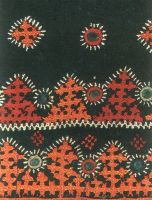
|
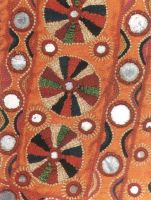
|
Hravatski
Povijesni Muszej
Katalog Musejskih Zbirki XXX
"Texstil-Paramenta. Crkveni tekstil Hrvatskoga
povijesnog muzeja"
by Snjezana Pavicic
Copyright © Hrvatsii
povijesni muzej
Zagreb, 1998, ISBN 953-6046-14-8
Text in croatian language,
with an english and a german summery. There are 122
pages. It is illustrated by 128 very good mostly coloured
photographs.
reported by A.W.
The catalogue includes all the textiles and
leather objects made between ther 14th and the
middle of the 19th c. in domestic and foreign
workshops. Most of the objects come from the
continental part of Croatia, and a smaller number
from the costal region.From existing scant literature about
domestic specialised workshops for the
manufacture of church textiles the weavers’
guilds in Dubrovnik can be pointed out. The
renowned weaver Wolfgang Jacob Stoll from
Ingolstadt worked in Zagreb in the middle of the
17th c. Besides there existed the work of the
Pauline workshops and especially the convent
centres of the Benedictine nuns in Rijeka,
the Ursuline nuns in Zadar and the sisters
of Mercy in Zagreb.
High quality work was done by the Ursuline nun
Mater Michaela Karba and the sister of
Mercy Ksaverija Skuba.
|

gloves, 18th/19th c.,
HPM/PMH 19693, p.76 |
| The
oldest amd rarest object is the "Avinon
standard" of cut red velvet with a cross
that was probably embroidered in the 15th cent.
with traces of elements made in the gothic
tradition. |
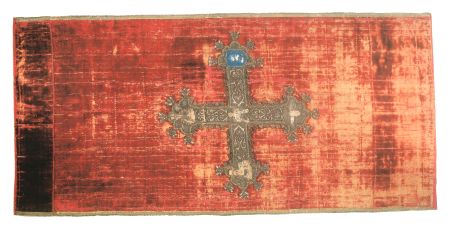
|
|

